Peugeot unveils 307 WRC.
The Frankfurt Motor Show was the slightly unlikely setting for what was being billed as the third important event in the recent sporting history of Automobiles Peugeot - the launch of its new 307 WRC rally 'weapon'.
Following on from February 1983, and the presentation of the 205 Turbo 16 alongside the road going 205 range, and then June 1998, with the simultaneous presentation of the 206 and its rallying derivative the 206 WRC, Frankfurt marked the turn of the 307 to enhance its range with the arrival of its World Rally Championship sister.
The Frankfurt Motor Show was the slightly unlikely setting for what was being billed as the third important event in the recent sporting history of Automobiles Peugeot - the launch of its new 307 WRC rally 'weapon'.
Following on from February 1983, and the presentation of the 205 Turbo 16 alongside the road going 205 range, and then June 1998, with the simultaneous presentation of the 206 and its rallying derivative the 206 WRC, Frankfurt marked the turn of the 307 to enhance its range with the arrival of its World Rally Championship sister.
Based on the top-of-the-range 307CC, fitted with an engine developing 180bhp, the 307 WRC is Peugeot's next rally project, its destiny being to replace the 206 WRC as its bows out as a triple world champion. Its somewhat belated arrival, in the coup? version, is the result of the advances in made the development of the 206 WRC, which continues to pose a threat to its rivals on the world rally scene and has enabled the Peugeot Sport team to perfect the new car before its launch.
The 307 WRC first turned its wheels on Christmas Eve 2002 and, since then, the test sessions have become more frequent, both off and on road. Pre-planning studies began 15 months ago, a choice finally being made in favour of a CC version at the request of Peugeot management and its marketing department, with production of an even more effective version of the Coup? Cabriolet also being a top priority.
Although heavier than the saloon, like any coup? cabriolet, the 307 CC requires a certain number of stiffeners. However, the 307 WRC project benefited from new legislation which increased the minimum legal weight of the body to 320kg.
One innovation on the 307 WRC is its gearbox - a five-speed Hewland unit - which is located at the rear of the engine in a transverse position, contrary to the one on the 206 WRC which is in a longitudinal position. A conical counter gear situated behind the centre differential provides the drive to the rear wheels. The three differentials - front, centre and rear - are all electronically managed.
Another new feature is that the engine is no longer the XU9J4, but the more recent XU7JP4, although the new unit still utilises an aluminium block. This engine is regularly fitted to the 1.8-litre version of the 406 saloon, but is enlarged to two-litres for the 307 WRC. Power is judged at approximately 300bhp at an engine speed of 5250rpm. Torque stands at 580 Nm at 3500 rpm.
The new car is 329cm longer than its predecessor, although width remains identical. A consequence of the increased length is longer wheelbase, rising from 2.468m to 2.610m. Base weight remains at the 206 WRC's 1230kg.
Homologation of the competition car will be required by January 2004, in which time 2500 versions must have been produced. At the same time, 25.000 vehicles in the 307 CC range must roll off the production line in twelve consecutive months.
The 307 WRC is expected to line-up at the start of the Rallye Monte Carlo next January.
